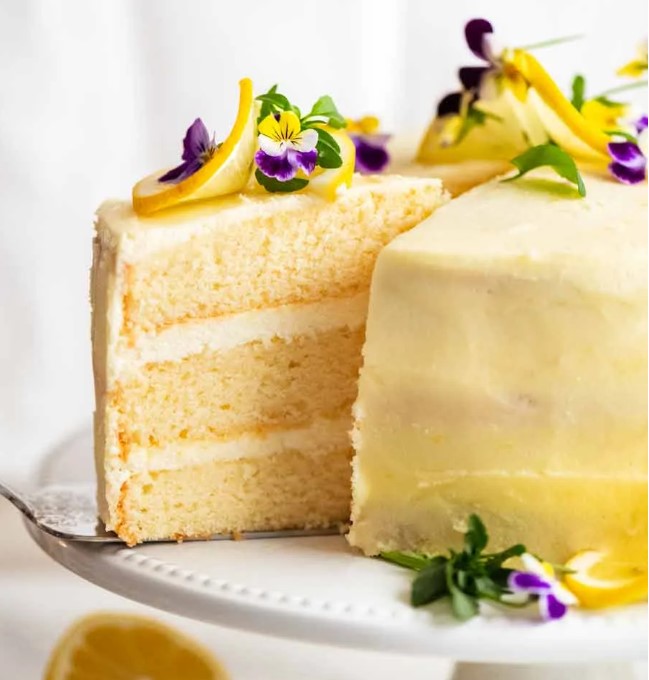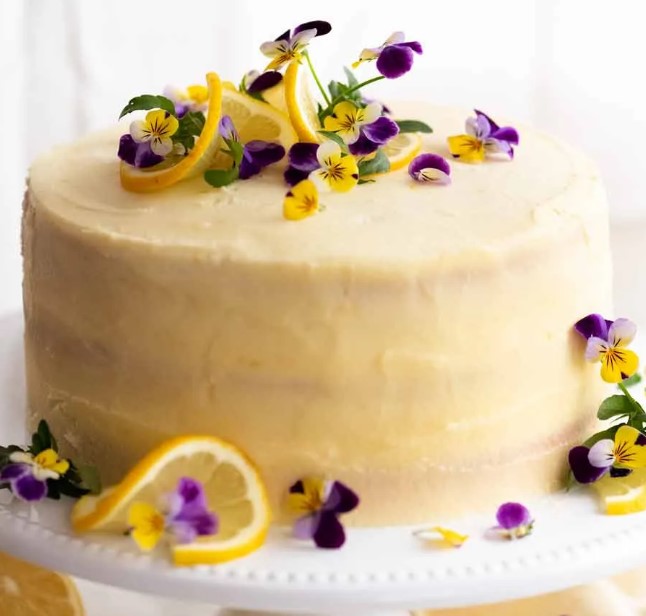
Lemon Cake with Fluffy, Less-Sweet Lemon Frosting
This is the Lemon Cake you make when you want to impress. 3 cake layers with a velvety, tender crumb based on my signature Vanilla Cake recipe that readers around the world have fallen in love with.
Ingredients
Lemon Cake
2 cups plain / all purpose flour (cake flour OK too, Note 1)
2 1/2 teaspoons baking powder (check it’s still active, Note 2)
1/4 tsp salt
4 large eggs (50 – 55g / 2 oz each), at room temp (Note 3)
1 1/2 cups caster / superfine sugar (granulated/regular ok too, Note 2)
115g / 1/2 cup unsalted butter , cut into 1.5cm / 1/2” cubes (or so)
1 cup milk , full fat (Note 5)
3 tsp vanilla extract , the best you can afford (Note 6)
3 tsp vegetable or canola oil (Note 7)
3 tbsp lemon zest (from 2 lemons)
1/3 cup lemon juice
1/4 tsp natural lemon extract (lemon oil) , recommended but not essential (Note 8)
My secret Less-Sweet Lemon Frosting:
6 1/2 tbsp flour, plain/all purpose
1 1/3 cups milk (full fat best, low fat ok, 0% fat no good)
1 1/3 cups caster / superfine white sugar (or granulated/ordinary)
300g / 1 1/3 cups unsalted butter , softened
3 tsp lemon zest (from 1 lemon)
4 tbsp fresh lemon juice

Instructions
Preparation:
Preheat oven to 180°C/350°F (160°C fan) for 20 minutes before starting the batter (Note 9). Place shelf in the middle of the oven.
Cake pans: Grease 3 x 20cm / 8” cake pans with butter, then line with parchment / baking paper. (Note 10 more pan sizes) Best to use cake pan without loose base, if you can.
Combine Dry Ingredients
Whisk flour, baking powder and salt in a large bowl. Set aside.
Beat eggs until aerated:
Beat eggs for 30 seconds on speed 6 of a Stand Mixer fitted with a whisk attachment, or hand beater.
With the beater still going, pour the sugar in over 45 seconds.
Then beat for 7 minutes on speed 8, or until tripled in volume and white.
Finish cake batter:
Heat Milk-Butter: While egg is beating, place butter and milk in a heatproof jug and microwave 2 minutes on high to melt butter (or use stove). Do not let milk bubble and boil (foam is ok). If you do this ahead, cover and keep hot while beating eggs.
Gently add flour: When the egg is whipped, scatter 1/3 flour across surface, then beat on Speed 1 for 5 seconds. Add half remaining flour, then mix on Speed 1 for 5 sec. Add remaining flour, then mix on Speed 1 for 5 – 10 sec until the flour is just mixed in. Once you can’t see flour, stop straight away.
Lighten hot milk with some Egg Batter: Pour hot milk, vanilla, lemon juice and zest and oil into the now empty flour bowl. Add about 1 1/2 cups (2 ladles or so) of the Egg Batter into the Milk-Butter (don’t need to be 100% accurate with amount). Use a whisk to mix until smooth – you can be vigorous here. Will look foamy.
Slowly add milk: Turn beater back on Speed 1 then pour the Milk mixture into the Egg Batter over 15 seconds, then turn beater off.
Scrape and final mix: Scrape down sides and base of bowl. Beat on Speed 1 for 10 seconds – batter should now be smooth and pourable.
Bake:
Pour batter into pans.
Knock out bubbles: Bang each cake pan on the counter 3 times to knock out big bubbles (Note 10 for why)
Bake 23 minutes or until golden and toothpick inserted into centre comes out clean.
Cool & frost:
Remove from oven. Cool in cake pans for 15 minutes, then gently turn out onto cooling racks. If using as layer cakes, cool upside down – slight dome will flatten perfectly. Level cake = neat layers.
Frost with provided Lemon Frosting, or Lemon Cream Cheese Frosting from this Lemon Blueberry Layer Cake recipe.
Secret Less-Sweet Fluffy Lemon Frosting:
Thickening roux: Place flour and sugar in a large saucepan over medium heat. Cook, stirring constantly, for 30 seconds.
Add milk: While whisking constantly, slowly pour the milk in (this ensure it’s lump free). As the milk gets hotter, it will start to thicken – stir constantly so the base doesn’t catch.
Thicken roux: Cook until the mixture thickens in a thick, dolloping custard – see video for texture. (Note 13 tip)
Cool: Remove from heat and scrape into a bowl. Cover with cling wrap, pressing down onto the surface to prevent a skin from forming. Cool completely (20 min counter then 30 min fridge), but do not let it get fridge cold. (Note 14) It will firm into a very thick paste.
FROSTING – cream butter: Beat butter with either a handheld beater or stand mixer (with whisk attachment) for 3 minutes until it’s smooth and changes from yellow to very pale yellow, almost white.
FROSTING – add roux: While beating on speed 5, add the roux one heaped tablespoon at a time. Take about 1 minute to add it all. Once all added, add lemon zest and juice, then whip for 2 minutes until you can see that it is stiff enough to hold peaks liek whipped cream. Do not whip more than 4 to 5 minutes (this will activate starch and make it sticky).
Frosting Cake:
Flip a cake layer upside down (for level surface). Spread with 3 – 4mm / 0.12 – 0.16″ frosting. Top with another upside cake layer, spread with ore frosting. Cover with final cake layer then use remaining frosting to cover top and sides.

Notes
To ensure success:
Read recipe from start to finish before starting;
Make sure your baking powder is not past its expiry – here’s how to check;
Fresh eggs make the cake rise properly (old eggs don’t aerate as well);
Work in order of steps per recipe;
Don’t incorporate add-ins like funfetti (they sink); and
Once you start, keep going until it’s in the oven. Do not at any point leave batter sitting around – bubbles will subside!
Stand Mixer speeds are for a Kitchen Aid and also for hand beaters.
RECIPE NOTES
1. Cake flour works just fine with this recipe, but butter and vanilla flavour, and crumb is ever so slightly better using plain / all purpose flour. Also, cake flour makes the cake surface sweaty and sticky the next day.
2. Caster / superfine sugar are finer grains than regular / granulated sugar so it dissolves when whipped with the eggs. Granulated / regular sugar sometimes doesn’t fully dissolve which doesn’t affect the cake rise or texture but can leave some very brown sugar specks on the surface / sides. Not a big deal – just visual if serving undecorated.
3. Eggs – important to be at room temp as they fluff better when whipped which is key to the fluffy texture of this cake. Also, fresher eggs aerate better = better rise. Old eggs don’t fluff as well.
Quick way to warm up fridge cold eggs – place in a large bowl, cover with warm tap water (just warm, not hot), leave for 5 minutes. Wipe dry (to avoid residual water dripping into bowl), then use per recipe.
Large eggs – 50 – 55g / 2 oz per egg this is the industry standard of egg sizes sold as “large eggs” in Australia and the US. If your eggs are significantly larger or smaller in size, just weigh your eggs and use 200 – 220g / 8 oz in total (including shell) or 180 – 200g / 7.3 oz in total excluding shell (this is useful if you need to use a partial egg to make up the total required weight. Just crack eggs, whisk THEN pour into a bowl to measure out what you need).
4. Baking powder – dead baking powder is a common problem with cake fails, even if not past the expiry date. Here’s how to check yours is still good.
Baking soda (bi-carb) won’t make the cake rise quite as well. If you have no choice, then use 3/4 teaspoons of baking soda.
5. Milk – if you sub with lower fat milk then the texture of the crumb becomes a little less tender. Do not substitute with non-dairy milk, such as soy or almond milk.
6. Vanilla come in all sorts of qualities. I use Vanilla Extract. Better quality (more expensive) = better flavour, but I think vanilla bean paste is wasted in cakes.
7. Oil – just 3 teaspoons makes a noticeable difference to the tenderness of the crumb AND keeps the crumb moist for days.
8. Natural lemon extract – To give the lemon flavour a slight boost! Comes in small bottles like food colouring. Not essential, but does drive home that lemon flavour in a way you can’t achieve using just juice and zest (unless you use way more which compromises cake rise).
9. Oven preheating – 30 minutes preheat is recommended to ensure no loss of heat when the oven door is opened. Never use the rapid heat function on your oven for baking, no matter how fancy your oven is!
10. Cake pans:
Type – The batter is quite thin so to ensure no leakage, do not use a cake pan with a loose base. Springform is ok but use butter to firmly fill the gap and for extra insurance, try to cut the paper for the base slightly larger so it goes slightly up the wall.
Don’t have 3 cake pans? Fill one 20cm/8″ cake pan with 2/3 of the mixture (bake 32 min) and the other with 1/3 (bake 23 min). Split the larger one in half once cool.
Baking on different shelves – If they don’t all fit, put 2 on the middle shelf and one on shelf below. Take out top 2 at 23 minutes, then move bottom one up and bake for further 2 minutes.
Cake pan sizes – click here for a useful table of different cake pan sizes, cake height and bake times.
11. Knock out big bubbles by banging pan on counter that causes irregular holes inside crumb and unsightly bubble brown spots on the surface. Does not burst the tiny bubbles that make the cake rise – they are too small to bang out!
12. Cake sweetness note – sweeter than Asian cakes, less sweet than typical Western butter cakes. Please do not reduce sugar – 1 1/2 cups is minimum required to make the eggs foamy enough to rise.
13. Roux thickness – Thicker texture = thicker frosting texture but won’t make the frosting dense, it’s still fluffy and spreadable but it just makes it “sturdier” with sharper edges when piped.
14. Cooling roux down – Roux needs to be at room temp (17 – 20°C /63-68°F in order to incorporate with the butter. If too hot, will melt butter. If too cold, won’t blend in with butter. You can leave in fridge overnight but take it out 1 hour prior to using (to dechill – otherwise it won’t mix well with softened butter).
Leave a Reply